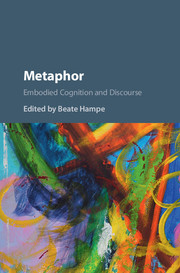Book contents
- MetaphorEmbodied Cognition and Discourse
- Metaphor
- Copyright page
- Contents
- Figures
- Tables
- Contributors
- Editor’s Preface and Acknowledgments
- Introduction
- Part I Metaphor in Cognition
- 2 Sources and Targets in Primary Metaphor Theory: Looking Back and Thinking Ahead
- 3 The Hierarchical Structure of Mental Metaphors
- 4 Metaphorical Directionality: The Role of Language
- 5 Body Schema and Body Image in Metaphorical Cognition
- 6 Primary Metaphors Are Both Cultural and Embodied
- Part II More than Metaphor
- Part III Metaphor in Discourse
- Part IV Salient Metaphor
- Epilogue (A Personal View)
- References
- Person Index
- Subject Index
5 - Body Schema and Body Image in Metaphorical Cognition
from Part I - Metaphor in Cognition
Published online by Cambridge University Press: 05 July 2017
- MetaphorEmbodied Cognition and Discourse
- Metaphor
- Copyright page
- Contents
- Figures
- Tables
- Contributors
- Editor’s Preface and Acknowledgments
- Introduction
- Part I Metaphor in Cognition
- 2 Sources and Targets in Primary Metaphor Theory: Looking Back and Thinking Ahead
- 3 The Hierarchical Structure of Mental Metaphors
- 4 Metaphorical Directionality: The Role of Language
- 5 Body Schema and Body Image in Metaphorical Cognition
- 6 Primary Metaphors Are Both Cultural and Embodied
- Part II More than Metaphor
- Part III Metaphor in Discourse
- Part IV Salient Metaphor
- Epilogue (A Personal View)
- References
- Person Index
- Subject Index
Summary
Neurologists, philosophers, psychologists, and also linguists frequently employ the notion of the ‘body schema.’ Many divergent definitions of this notion were provided till Shaun Gallagher (1986) clarified the terminological and conceptual confusion by proposing a clear distinction between the two concepts of ‘body schema’ and ‘body image.’ I propose that two different roles played by the body in cognition can be identified on the basis of this distinction, corresponding to two different levels of embodiment. In this account, a first level of embodiment is constituted by invisible metonymies that have aspects of the body schema as their source domain. Visible metaphors occur at a second level of embodiment and take their source domains from aspects of the body image. In the first case, the mapping is directly from sensorimotor abilities to perception; in the second case, the mapping is from concepts that are related to our bodily experiences to abstract concepts.
Information
- Type
- Chapter
- Information
- MetaphorEmbodied Cognition and Discourse, pp. 82 - 98Publisher: Cambridge University PressPrint publication year: 2017
Accessibility standard: Unknown
Why this information is here
This section outlines the accessibility features of this content - including support for screen readers, full keyboard navigation and high-contrast display options. This may not be relevant for you.Accessibility Information
- 5
- Cited by
